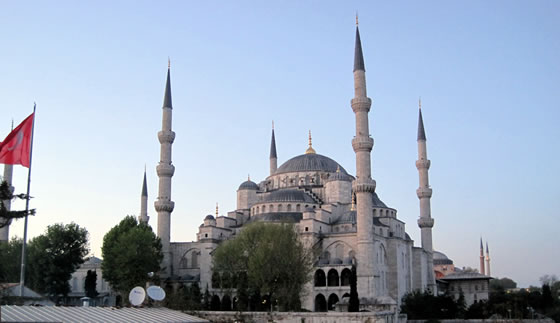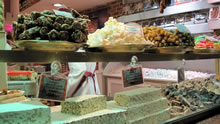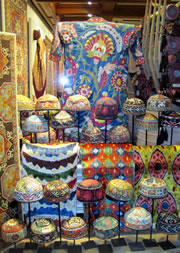 |  |  | |
News & Notices
Nominations Open for:
In Memoriam:
News From:
Commissions
Conference & Stage Expo
For the Record
 | ||
| Study Tour to Experience Turkey and PQ 2011 Openings are still available for the 2011 USITT Study Tour May 31 through June 19. Participants will travel through Turkey with the tour culminating at the 2011 Prague Quadrennial at Performance Design + Space. Turkey is a democratic, secular, unitary, constitutional republic with an ancient cultural heritage. Considered a regional power, Turkey is a NATO member, a member of the Economic G20, and a close ally of the United States. Its big cities, Istanbul, Ankara, and Izmir are modern bustling metropolises with subway systems, high-rise buildings, modern museums, and state supported theatres. Its many Greek ruins are protected and are some of the best-preserved ancient sites in the world. Turkey's Aegean shores are among the loveliest landscapes in the country. The magnificent coastline, lapped by the clear water of the Aegean Sea, abounds in vast and pristine beaches surrounded by olive groves, rocky crags, and pine woods. The coastline is dotted with idyllic fishing harbors, popular holiday villages, and the remains of ancient civilizations attesting to the inheritance of more than 5,000 years of history, culture, and mythology. The tour will start out in Istanbul, the former heart of the Ottoman Empire, a city that sprawls across two continents. There participants will meet colleagues from the theatres of Istanbul and the University of Istanbul and gain insight into contemporary theatre practice in Turkey. Visits to theatres such as the Municipal Theatre of Istanbul and the Rumeli Hisari, the historic Ottoman walled fortress on the banks of the Bosphorus, where plays are performed in open air, are planned. The tour will visit the Topkapi, the Ottoman Palace and its magnificent treasury, the Museum of Turkish and Islamic Arts, built in 1520, housing massive traditional handmade carpets, ceramics, and a fascinating ethnographic collection.
The next stop is the first capital of the Ottoman Empire, Bursa, the silk capital of Turkey and home of the famous Karagoz shadow puppets. Bursa is home to two contemporary theatres. The Ahmet Vefik Paşa was originally established in 1879 as the first modern theatre of that period. Rebuilt after a fire, it is now the largest theatre in Bursa with one big theatre hall, two chamber theatres, and a rehearsal stage. Another theatre to visit is the Tayyare, which was opened for films and plays in 1932 and underwent a 1995 restoration. Bursa is also known for its fourteenth and fifteenth century mosques, some of the most significant architecture of the period, and its well-preserved Ottoman houses.
From Assos, the tour heads south to Bergama. The town is best known in its former incarnation as Pergamon, the cultural center of a rich and powerful small kingdom during Greek and Roman times. Pergamon had a fine acropolis, the ruins of which survive today, including a 10,000-seat natural theater and a Temple of Dionysus. Selçuk, the gateway to Ephesus (one of the most significant archeological sites in the world) will be next. Founded by Ionian Greeks, it features an ancient amphitheatre which seated 44,000 people and is thought to have been the largest theatre in the ancient world. Selçuk is traditionally known as the home of the Virgin Mary after the death of Jesus Christ. From Ephesus the group will travel to the villages of Prienne, Miletus, and Didyma to see the ancient ruins and perhaps take a swim before catching a flight back to Istanbul. After a day and an evening of relaxing, doing some last minute shopping, or visiting the Sadberk Hanim Museum and its fascinating Ottoman artifacts, the group will say goodbye to Turkey and fly to Prague for the opening of the Prague Quadrennial of Performance Design & Space 2011. For questions, contact Marianne Custer at mcuster@utk.edu. | Colorful and interesting experiences are expected when the USITT 2011 Study Tour visits Turkey, which is a constitution republic which had protected many of its ancient ruins. Photos/Marianne Custer | |
United States Institute for Theatre Technology, Inc.: © 2010 Volume L, Number 9
 A cruise on the Bosphorus to the mouth of the Black Sea, strolling the Grand Bazaar, and enjoying the sights and scents of the Spice Bazaar are just a few of the many activities planned for this ancient city of mysteries.
A cruise on the Bosphorus to the mouth of the Black Sea, strolling the Grand Bazaar, and enjoying the sights and scents of the Spice Bazaar are just a few of the many activities planned for this ancient city of mysteries.  Participants will stop to see the ruins of Troy, site of Homer’s Illiad and Odyssey, on the way to the coastal town of Assos and its pristine Aegean waters. It will be time to rest while making brief visits to the ancient village of Behramkale and the ninth century Doric temple of Athena that crowns the hill overlooking the sea. A Roman amphitheatre sits nested against the hillside on the path to the village.
Participants will stop to see the ruins of Troy, site of Homer’s Illiad and Odyssey, on the way to the coastal town of Assos and its pristine Aegean waters. It will be time to rest while making brief visits to the ancient village of Behramkale and the ninth century Doric temple of Athena that crowns the hill overlooking the sea. A Roman amphitheatre sits nested against the hillside on the path to the village.